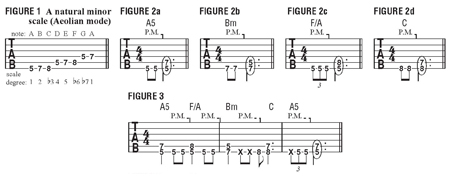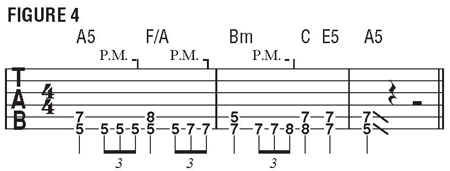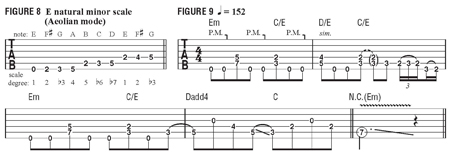Metal For Life: Power Surge

How to build power chord variations for maximum sonic effect.
My students often ask me how they can break away from typical root-fifth power chord rhythm figures. My solution is to devise a variety of different two-note chord shapes—built from pairs of notes, like root-fifth power chords—that sound great when applied to metal, even though these chord shapes can be used in virtually every style of guitar-based music.
To me, the simplest and most effective way to do this is to first take a look at metal’s most commonly used scale, natural minor, and then create note pairings built from various degrees of that scale.

FIGURE 1 shows the A natural minor scale (also known as the A Aeolian mode) in fifth position. The idea is to build two-note chords from different combinations of these scale degrees: FIGURE 2a illustrates a standard root-fifth A5 power chord, which combines the root note, A, and the fifth, E. FIGURE 2b combines B and D to create a two-note B minor chord voicing, FIGURE 2c combines A and F to create F/A, and FIGURE 2d combines C and E to create a C voicing. FIGURE 3 shows these chords used within the context of a progression.

Now, let’s create metal-style rhythm parts that use these two-note voicings. In FIGURE 4, I play the same chord progression but add palm-muted eighth-note triplet accents on the bass note of each chord throughout. Also, I’ve added one more two-note voicing, E5, sounded by barring the index finger across the bottom two strings at the seventh fret.

Let’s apply this concept to a hard-driving rhythm part. In FIGURE 5, I add palm-muted eighth-note accents on the bass note of each chord, creating a syncopated feel by accenting many of the power chords on the eighth-note upbeats.

Many metal bands feature a two-guitar lineup, and often the guitarists will play the same rhythm part but use different chord voicings to fill out the sound. FIGURE 6 represents the same rhythm pattern shown in FIGURE 5 but uses open strings and second-position chords.
All the latest guitar news, interviews, lessons, reviews, deals and more, direct to your inbox!

Another twist is to displace one of the notes of a two-note pair an octave higher, which will change the sound and texture of the chord dramatically while retaining its underlying harmonic quality. In FIGURE 7, I again play the same progression but change the C chord voicing by moving the C note up one octave so that the chord becomes C/E.

Now let’s apply this concept to another key. FIGURE 8 shows the E natural minor scale (E F# G A B C D), and FIGURE 9 depicts a chord sequence devised of two-note shapes built from this scale. There are only three different chord voicings used in this example—Em, C/E and D/E, all played against the open low-E string pedal tone. The only deviation is found in bar 4, wherein I incorporate the open G string to fill out the sound, resulting in the Dadd4 and C chord voicings.
